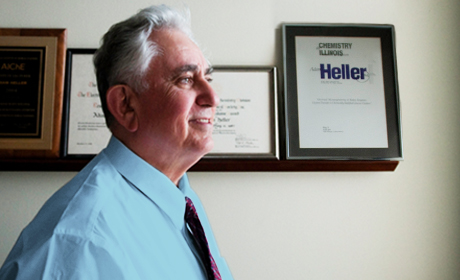In a career that has spanned nearly half a century, Dr. Adam Heller has repeatedly demonstrated an ability to turn scientific research into products that make a difference in people’s lives.

From battery technologies to biomedical devices, Heller’s work has formed the foundation for many products in use today, earning him widespread recognition and a slew of awards including the National Medal of Technology and Innovation.
Heller, a research professor in the Cockrell School of Engineering, attributes much of his success in transferring technology to the marketplace to a simple willingness to listen to others. It turns out, he says, that what you don’t know is often more important than what you do know in setting valid targets, realistic schedules and priorities.
“You must never confuse science or technology with a product,” Heller said. “Science and technology are necessary but, until you know what your product or service is, you do not have something transferable to society…You have to define it by working with the experts in the field and particularly with people who understand the extent of the societal need, i.e. the business. I listen to them. When it comes to making a decision on what I do, I base it on what I learn from them rather than on what I know how to do.”
Heller continues to focus on using science to improve the quality of people’s lives, such as creating technologies for pain management. According to Heller, it’s a process that requires adopting a collaborative mind-set.
“When you create a product, you have to act, behave and work profoundly differently than if your objective is academic recognition through publications and lectures,” Heller said. “We live in a world of complexity. There are few products or services that are simple enough for an individual to create. So you must work with other colleagues, and you have to learn how to make room for them. You must recognize that you are part of it; you are not it. That is where the world starts when you create products and services.”
Heller spent many years using science and technology to create products in his early career working for both GTE Laboratories and Bell Laboratories. While there, he developed the first inorganic liquid lasers and non-rechargeable lithium batteries, and helped colleagues develop high-density chip interconnection technology.
Since joining the university he has continued to find ways to take research from the lab to the market. Heller and his research team were issued the core patents on the electrical wiring of enzymes, bridging a gap between electronics and biology. It underlies a continuous monitor of glucose, an important tool for diabetes management.
Heller and his son, Ephraim, co-founded the company TheraSense to engineer and commercialize this monitor. This venture developed and launched FreeStyle™, the first glucose monitor that used minuscule blood samples (about 1/8th the blood volume taken by a mosquito) that were painlessly obtained. The success of FreeStyle™ allowed TheraSense to begin developing the continuous glucose monitor based on the electrical wiring of enzymes. TheraSense was acquired by Abbott Laboratories in 2004. Today, the FreeStyle™ and FreeStyle Navigator™ glucose monitoring systems are available worldwide.
The roots of Heller’s entrepreneurialism reach far back to his days at the Hebrew University, Jerusalem, where he earned his doctorate in chemistry in 1961. While there he studied under E.D. Bergman, who had a significant influence on Heller’s approach to research for the creation of products.
“He very much believed that research is here to serve people, to meet the needs of people,” Heller said. “The result is that all my life I tried to do research that was not only good by the standards of [academic] publishing, but also that served a need.”
With 102 patents, including 35 still in use, Heller holds more patents than any other faculty member at the university. This level of productivity has required a single-minded focus once a decision is made to tackle a problem.
“You have to learn to put all your eggs in one basket,” Heller said. “When you start building technology you cannot do it without committing yourself, because 24 hours a day to build a product is not enough. There is no room left to do anything else.”







